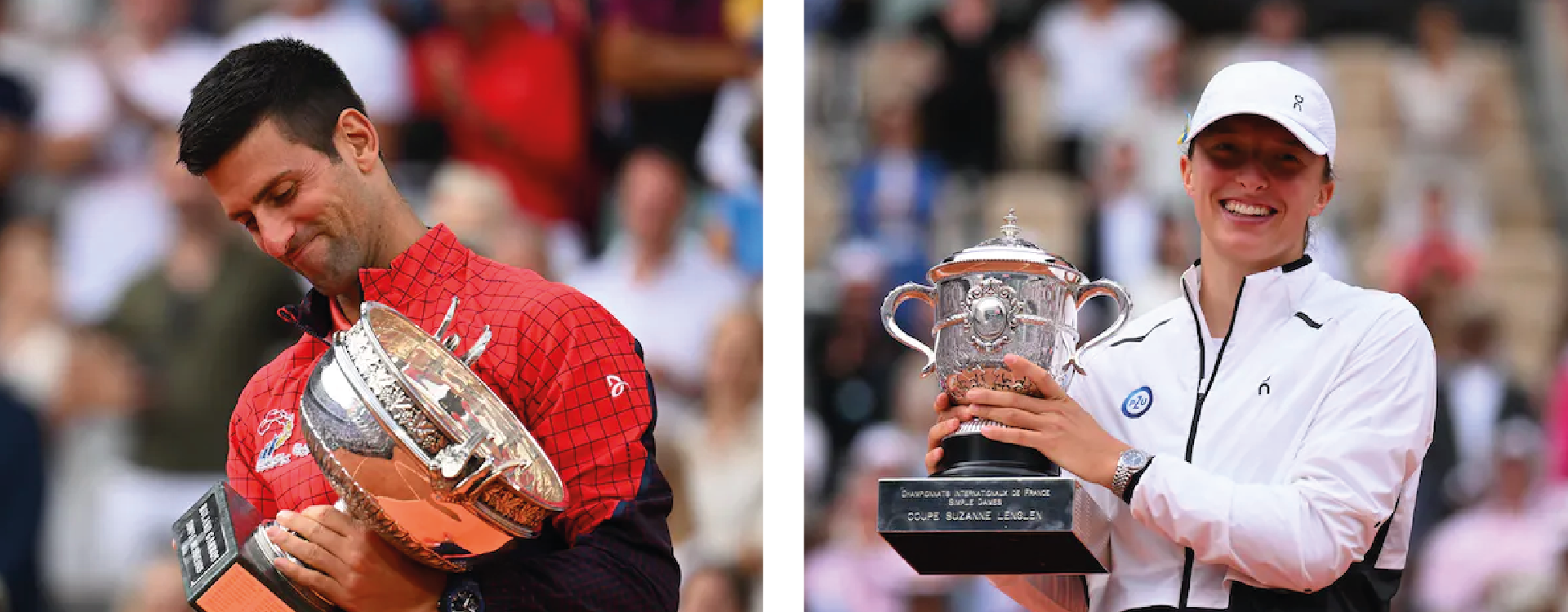
ATP & WTA Rankings (June 2023)
Let's take a look at the profiles of the players in the top 250 of the ATP and WTA rankings,
and see if there are any similarities or differences between them.
In this analysis, I compared two populations: all the 250 players and the top 20 of ATP & WTA players, to see if we can spot any characteristics that define a very good player, i.e. a top 20 player.
A special thank to Jeff Sackmann, who created and still update the 4 datasets used in this analysis.
2023 - Kevin Nicolas
In this article, we will see overall statistics about the players' profiles, with sub-categories about:
- Hands
- Heights
- Countries
- Focus on France
Strong Hands
In tennis, whether you're right-handed or left-handed, your game strategy won't be the same. Let's look the strong hand's distribution among the players.
ATP players' strong hand 👋
The world's population is 90% right-handed and 10% left-handed. Let's see if we find the same repartition among ATP players:
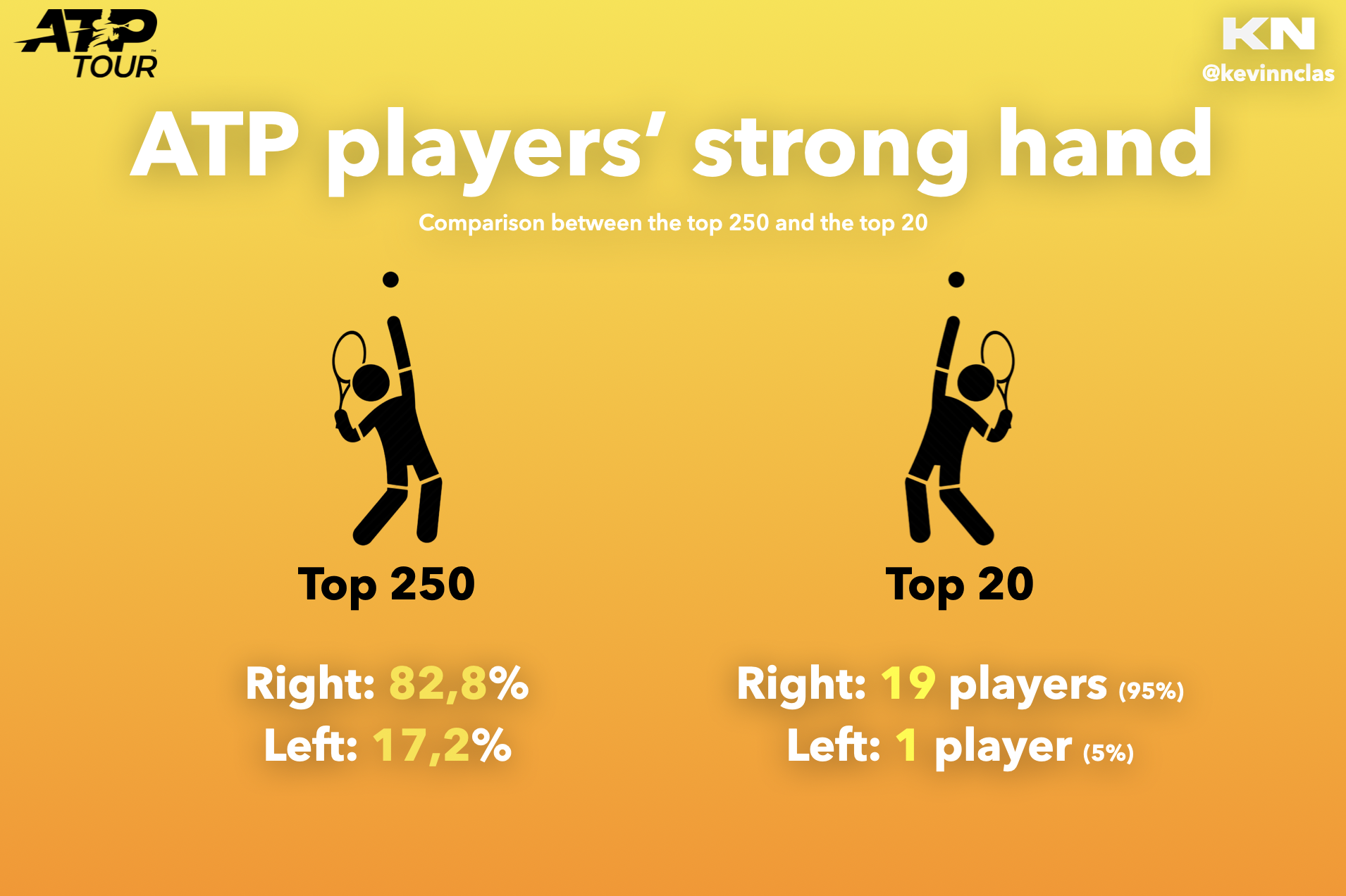
As we can see, on the 250 players, there are almost 83% of the players that are right-handed, and 17% are left-handed.
In the top 20, only one player is left-handed, that is Cameron Norie, actually ranked 14th.
In comparison with the world population, we can see that there are a lot of left-handed players among the top 250. They are less present in the top 20, so be left-handed shouldn't be a factor to be a great player. Everyone has a chance!
WTA players' strong hand 👋
Now, let's see if the distribution is similar with the WTA players:
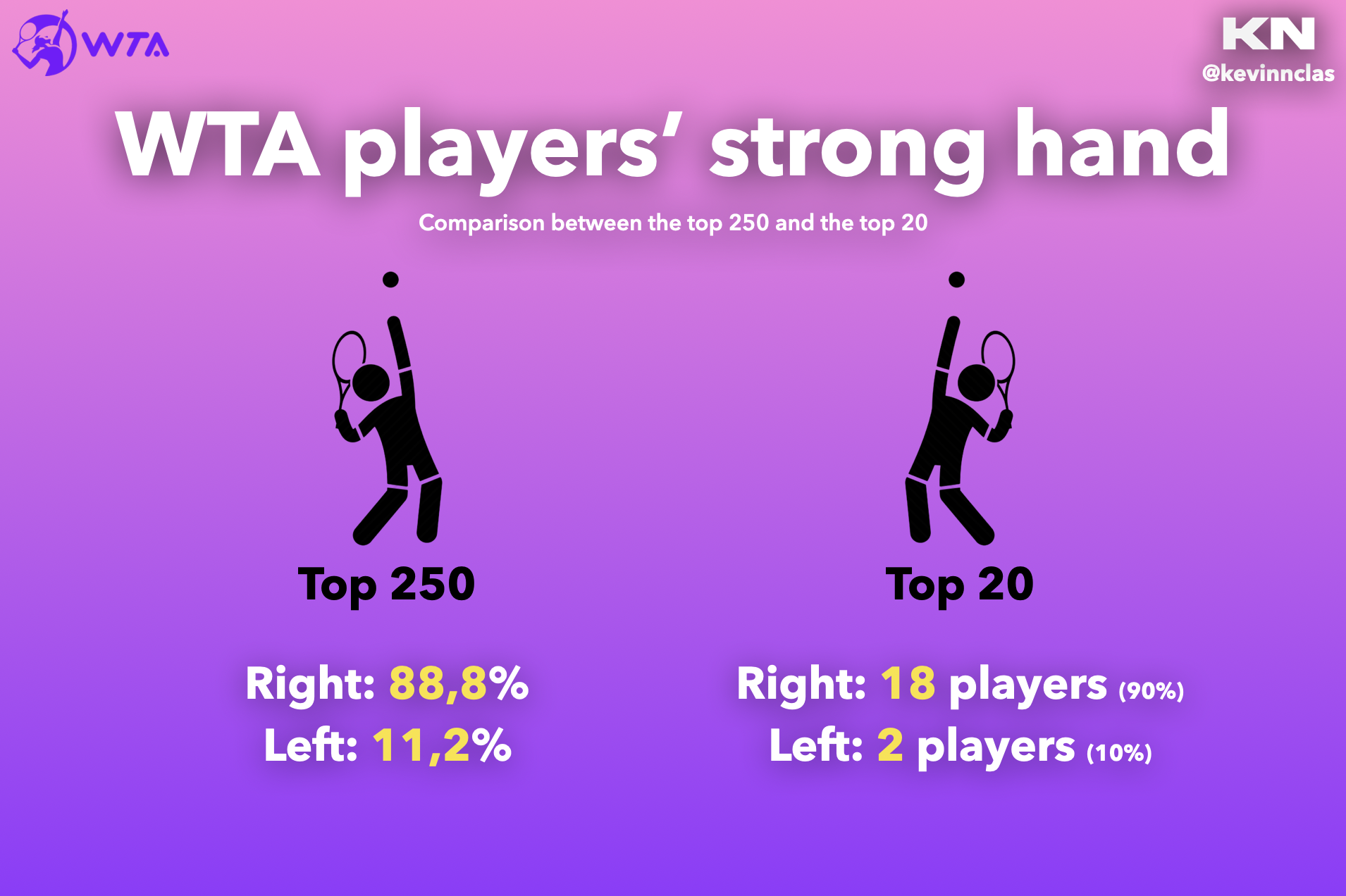
For WTA top 250 players, 89% of them are right-handed, and 11% are left-handed.
In the top 20, we have two players left-handed, that are Petra Kvitova, actually ranked 9th, and Beatriz Haddad Maia, ranked 13th.
Same as of the ATP players, a left hand as a strong hand doesn't really influence whether a player makes the top 20. However, as with ATP players, there is a higher proportion of left-handed players than in the rest of the population.
Heights
Now, we will focus on players' heights, to see if a tall player has an advantage over a smaller player.
ATP players' heights 📏
Let's remember that the average size of a male adult is about 180cm. What about the ATP top 250 players? Let's find out:
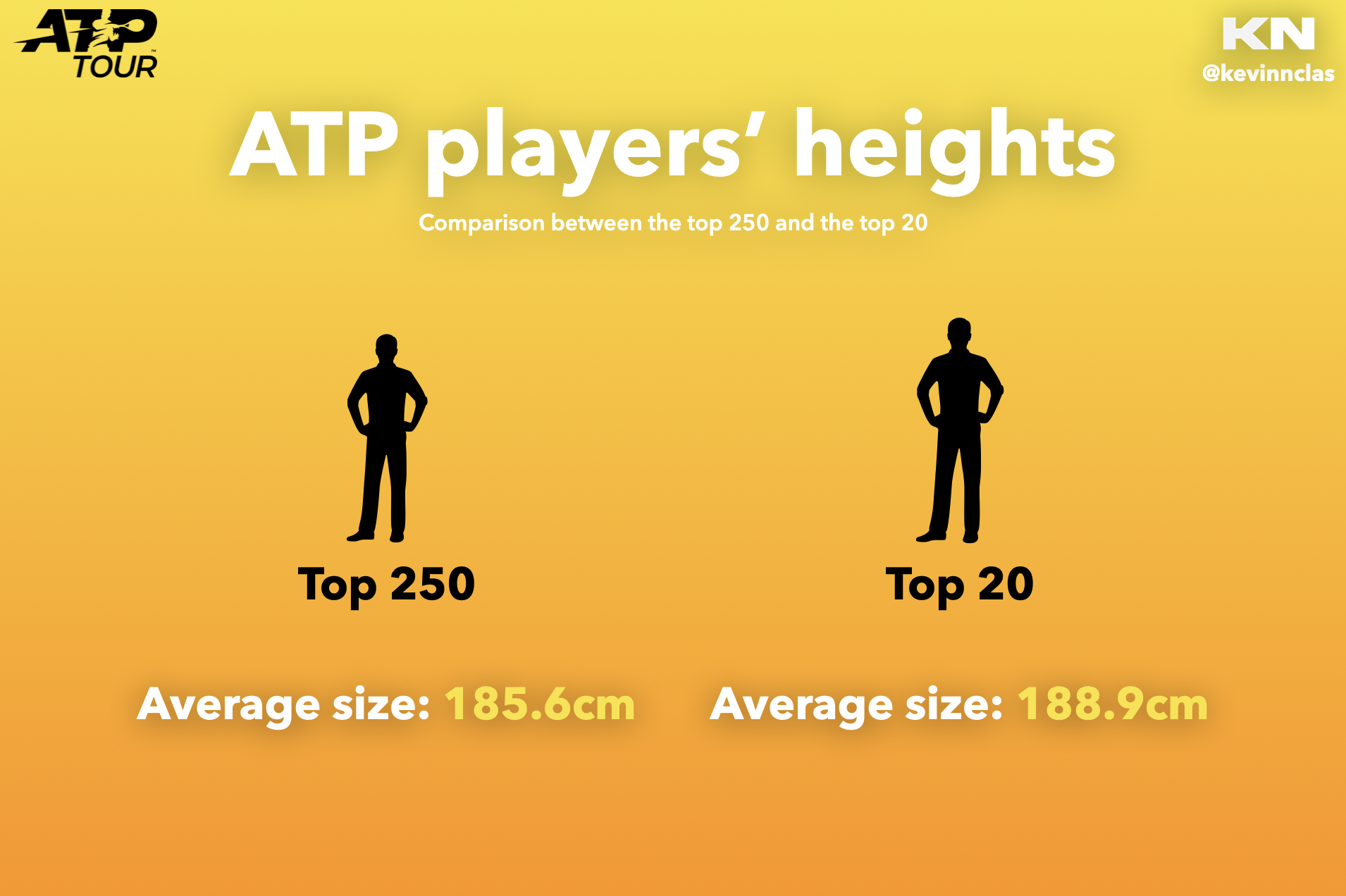
Surprisingly, we can see that the average size of ATP players is higher than average population. In fact, the average size is about 186cm for the top 250, and even 190cm for the top 20.
With a difference of 4cm on average between the top 20 and the rest of the players, we can maybe say that height is a good influencer for a tennis player, granting him to hit the ball with a better angle, with more power and to avoid the net more easily on a riskier ball.
WTA players' heights 📏
Let's remember that the average size of a female adult is about 165cm. What about the WTA top 250 players? Let's find out:
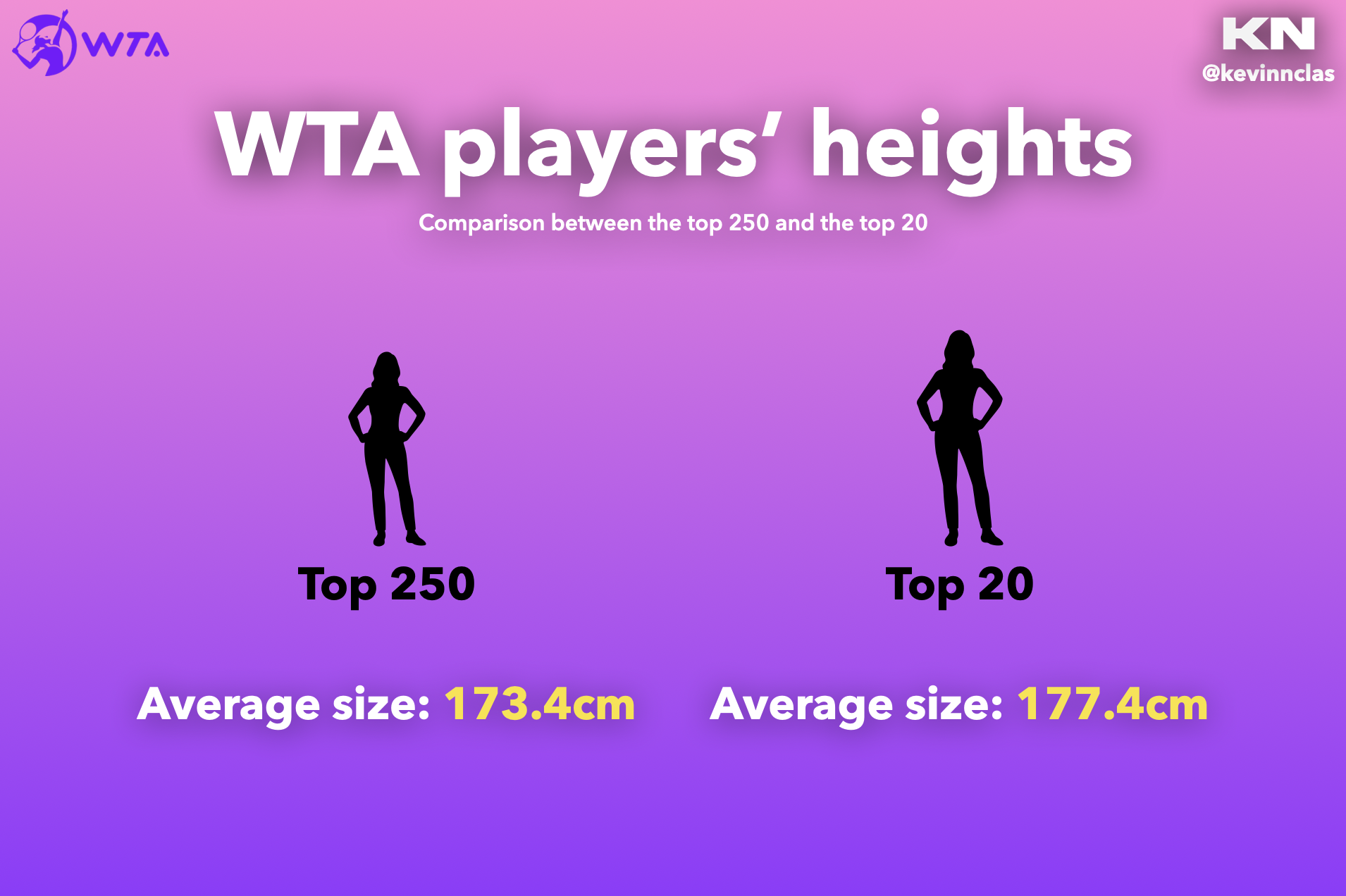
As for the men, we can see that the average size of WTA players is higher than average population. In fact, the average size for the top 250 is about 173cm, and 177cm for the top 20.
With also a difference of 4cm on average between the top 20 and the rest of the players, we can see the same difference in size that separates very good players from other professional players, for both men and women.
That's why we can say that tall players seems to have an advantage when it comes to winning at tennis.
Tallest players 🧍♂️
Let's find out who's the tallest ATP & WTA players:
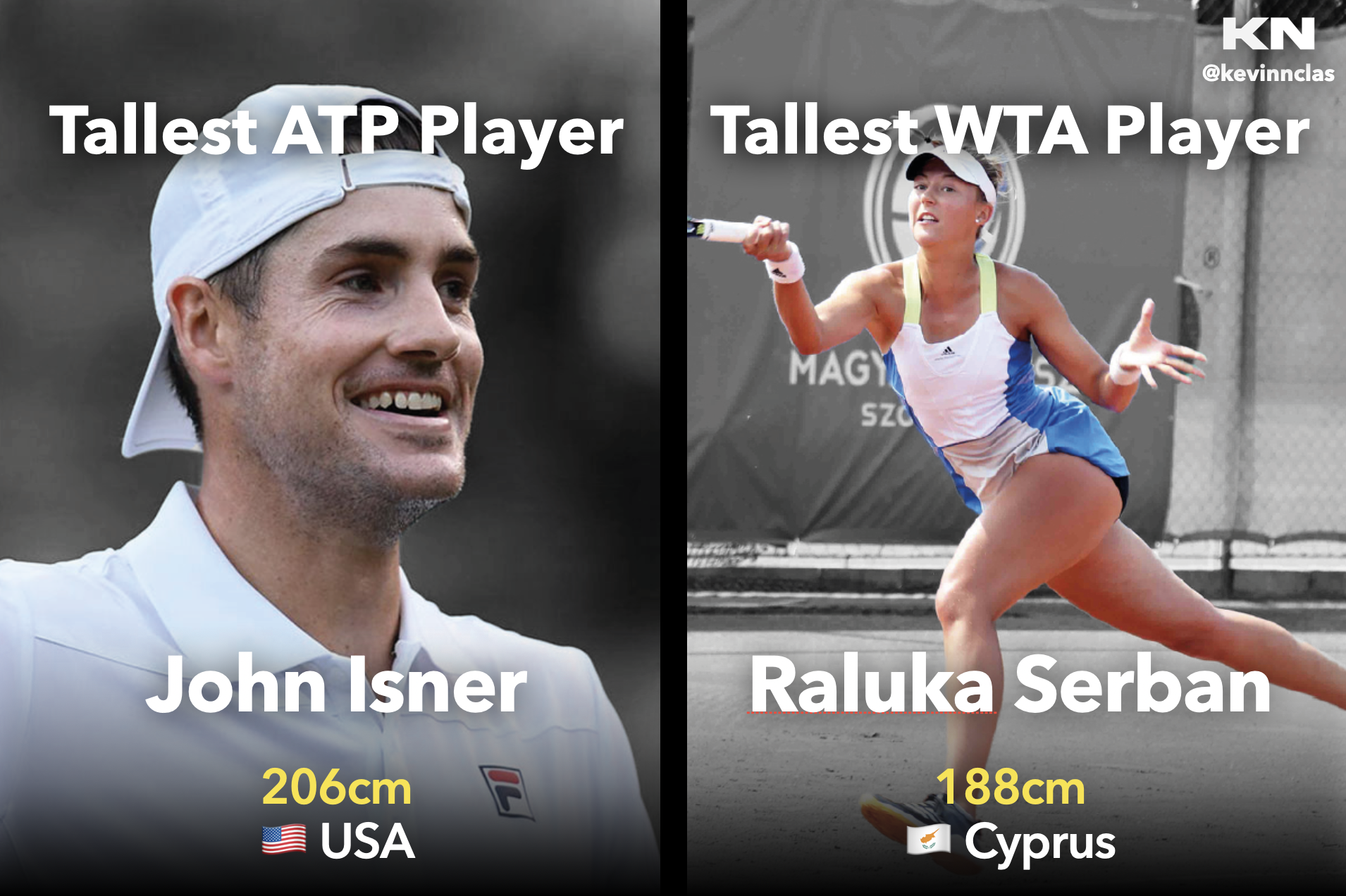
The tallest ATP player is John Isner, ranked 103rd, with 206cm. In the top 20, that's Daniil Medvedev who is the tallest, with 198cm and ranked 3rd.
Now in the WTA players, that's Raluka Serban who is the tallest player, ranked 173th and with a height of 188cm. In the top 20, that's Beatriz Haddad Maia who is the tallest, with 185cm and ranked 13th.
That's why we can say that tall players seems to have an advantage when it comes to winning at tennis.
Smallest players 🧍
Now, what about the smallest ATP & WTA players? Let's see:
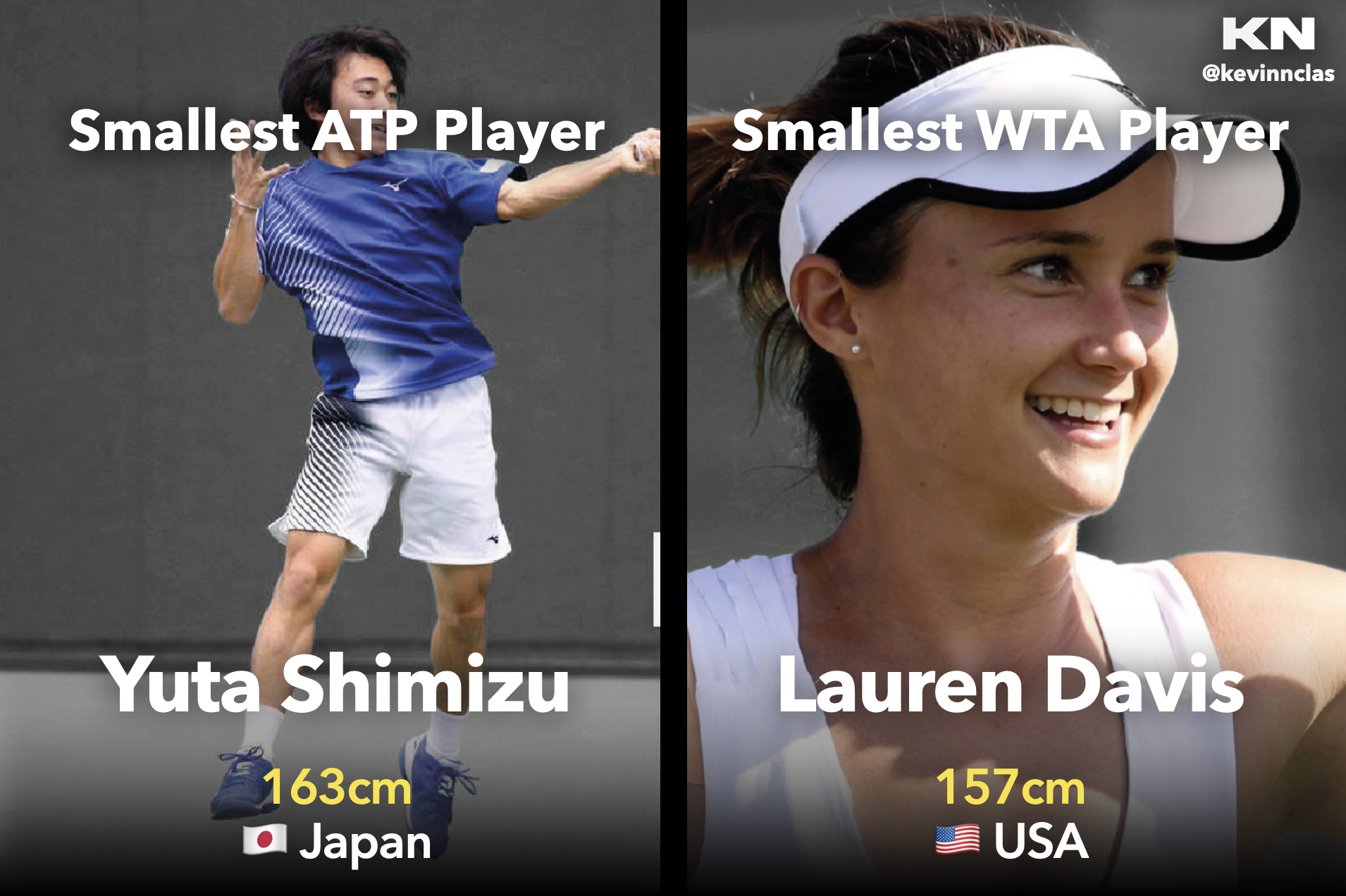
Even if they are smaller than average world population, some players are still among the best players of tennis. For the ATP ranking, the smallest player is Yuta Shimizu, ranked 246th, with 163cm. In the top 20, the smallest is Casper Ruud, with 183cm and ranked 4th.
Now for WTA players, that's Lauren Davis who is the smallest player, ranked 44th and with a height of 157cm. In the top 20, that's Ons Jabeur who is the smallest, with 167cm and ranked 6th.
It's interesting to se that the smallest players of the top 20 for ATP & WTA are still above the world average height.
Countries
Now we'll take a look at the country breakdown of the various ATP & WTA players:
ATP's most represented countries 🏳️
With 250 players from all around the world, let's see which country is the most represented by the ATP players:
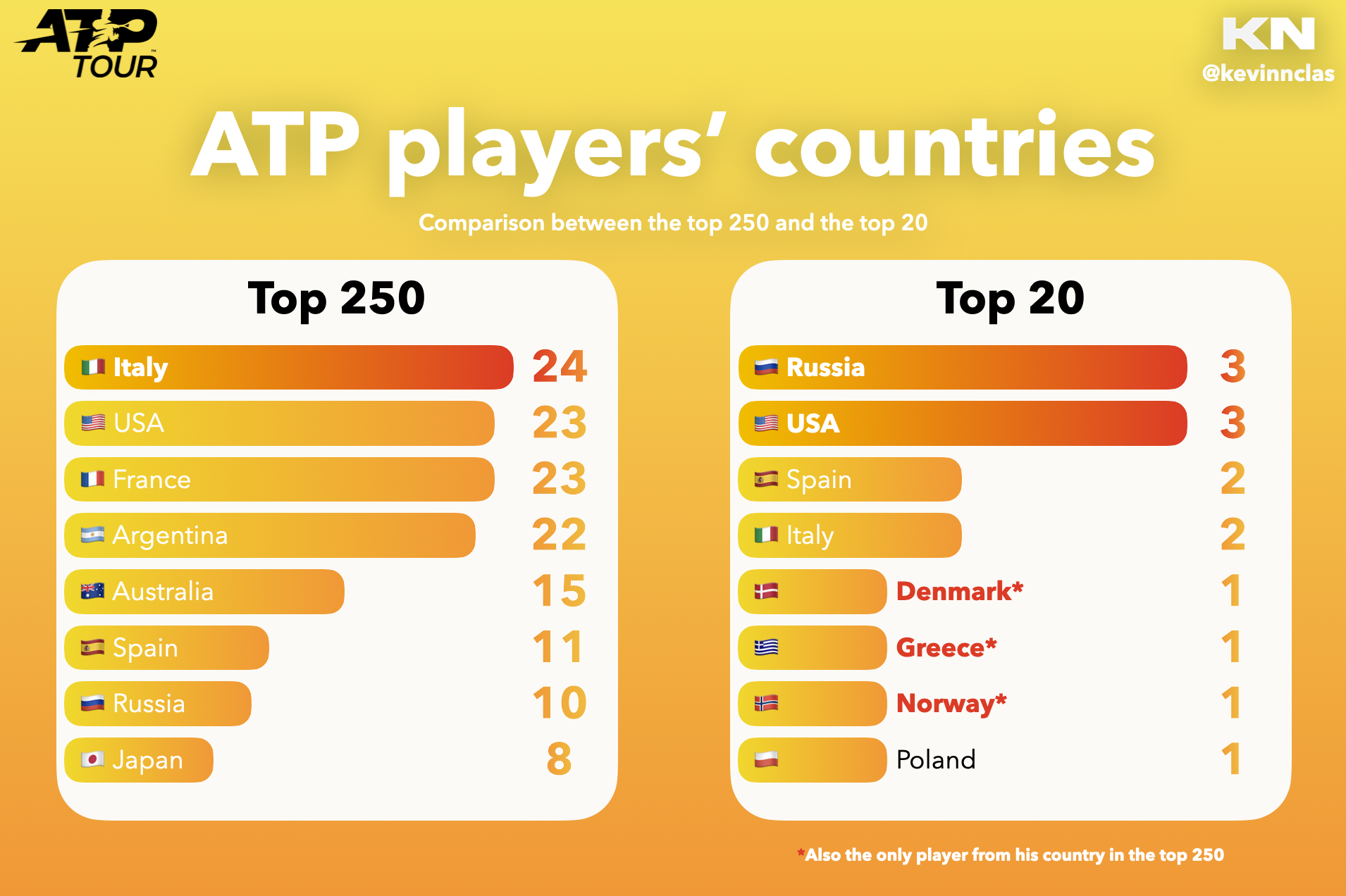
The most represented countries among the top 250 ATP players is Italy with 24 players. USA and France are right next after, with each 23 players.
Russia has only 10 players in the top 250. However, 3 of them are in the top 20, which is the most represented country among the best ATP players. USA has also 3 players in the top 20 ATP players.
Three players are in the top 20, and they are the only ones from their respective countries in the top 250:
- Casper Ruud from Norway
- Holger Rune from Denmark
- Stefanos Tsitsipas from Greece
They are very likely to be highly appreciated and supported in their own countries!
WTA's most represented countries 🏳️
Now, let's see which country is the most represented by the WTA players:
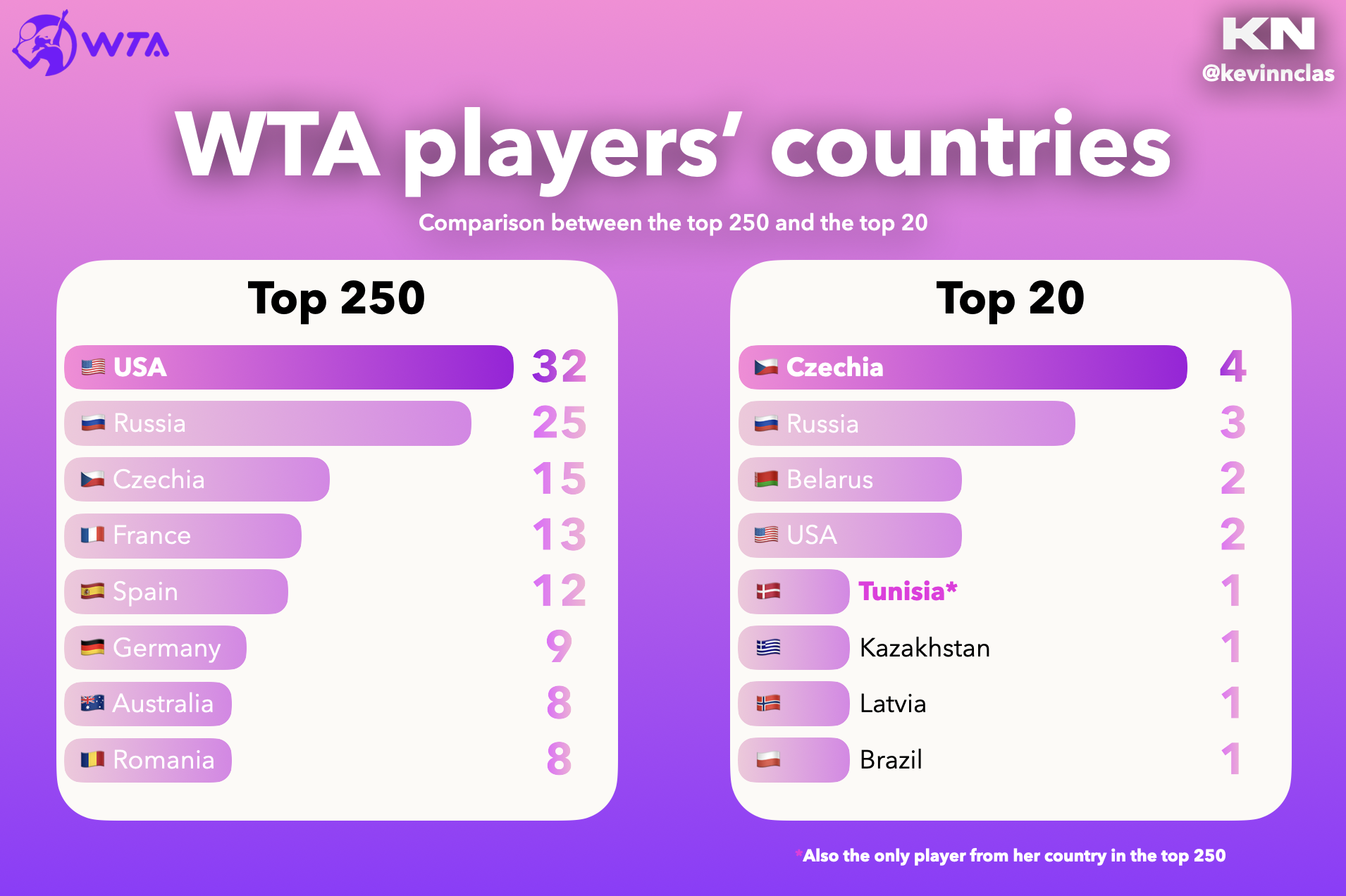
The most represented countries among the top 250 WTA players is USA with 32 players. USA is maybe the most represented country in the top 250 WTA players, but there are only 2 players in top 20 of WTA players.
The most represented country in the top 20 WTA-ranked players is Czechia, with 4 players. Czechia is also the 3rd most represented country in the top 250.
With 25 players from Russia in the top 25 and 3 players in the top 20, it's the 2nd most represented country either in the top 250 & the top 20 WTA players.
Only one player in the top 20 is her country's sole representative in the top 250:
- Ons Jabeur from Tunisia
ATP & WTA combined most represented countries 🌎
Now that we saw the ATP & WTA countries repartition, we will see how it changes if we combined ATP & WTA players:
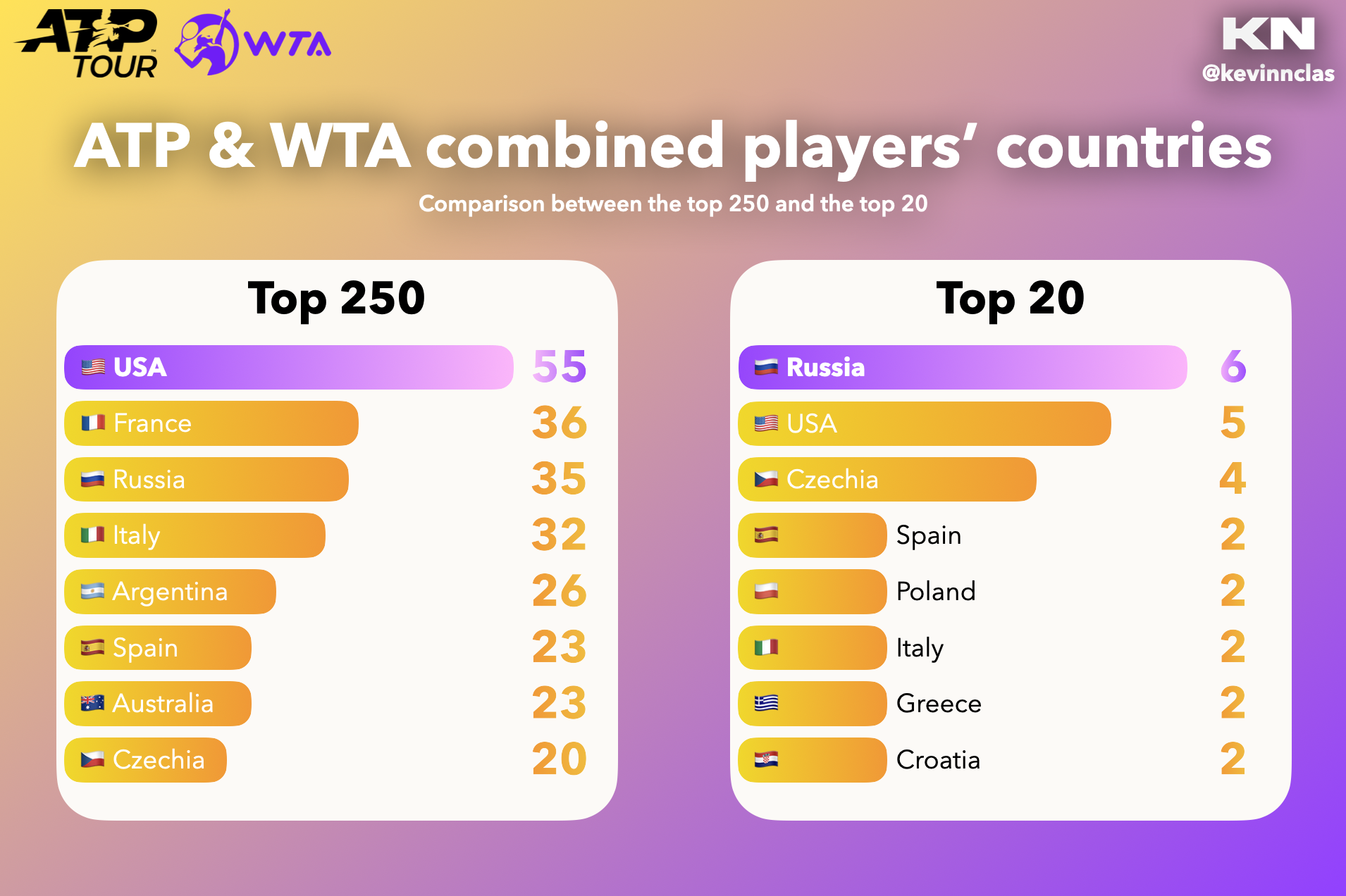
Among the combined top 250 ATP & WTA players, USA is the most represented country with 55 players. It's also the second most represented country in this top 20, with 5 players.
As we can see, Russia is the most represented country in the top 20 ATP & WTA-ranked players combined, with 6 players out of 40. It's the third most represented country in the top 250 ATP & WTA-ranked players combined.
ATP & WTA combined origin repartition 🌍
Finally, let's see the country repartition of combined ATP & WTA players:
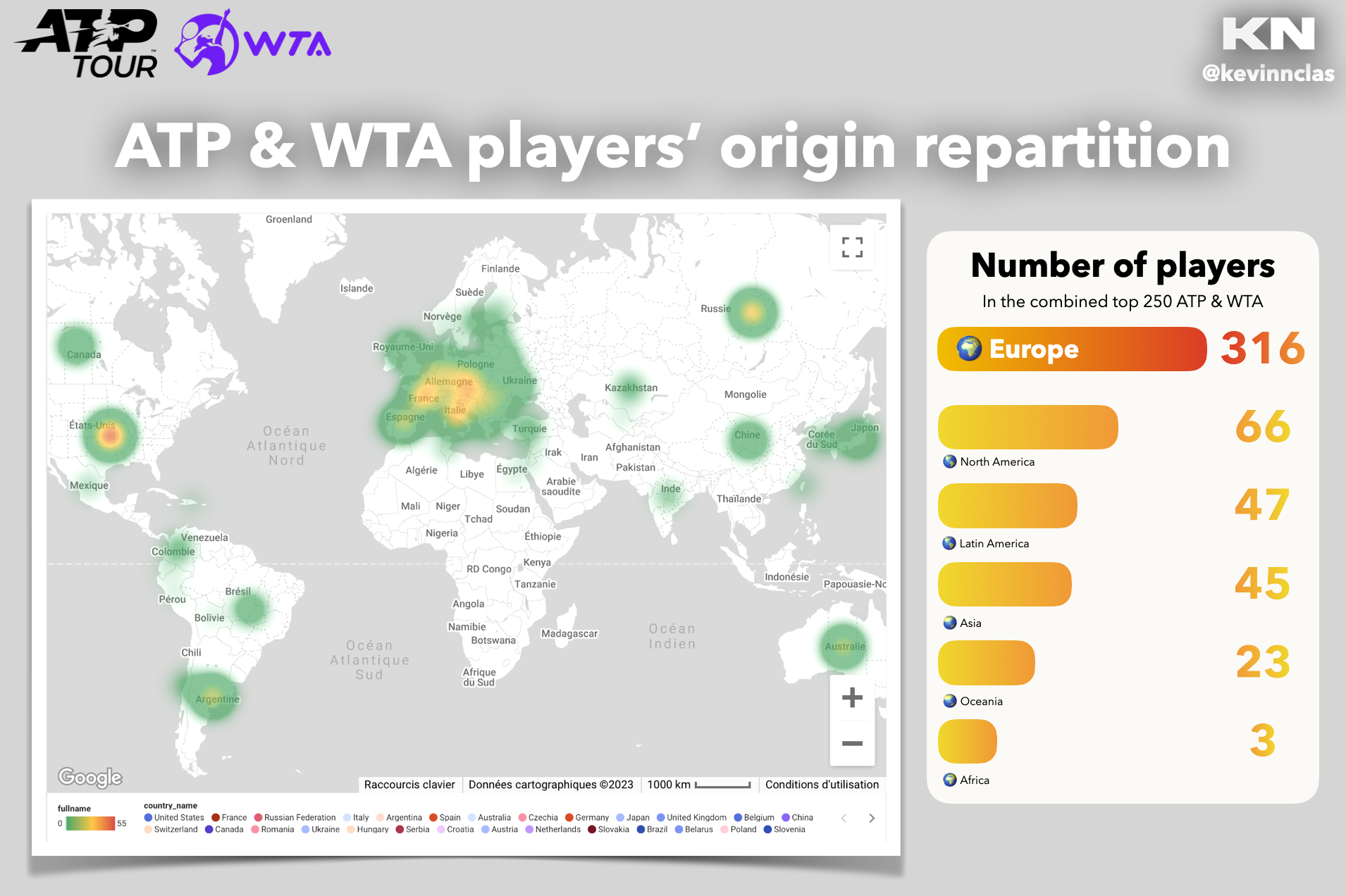
It's normal to find that most of the players from top 250 (and top 20) of ATP & WTA combined are from Europe, because it's the most represented continent, with 36 countries in the top 250. We have 316 players that are European.
However, we can see that North America has the 2nd most players in the top 20 and top 250, but it's the 2nd least represented continent with only 2 countries.
Focus on France
As we saw previously, France is in the top 3 of the most represented countries in the ATP & WTA combined top 250. But I did notice some differences between France and the other two countries in the top 3, that are USA and Russia. Let's see this in this section:
Focus on French players 🇫🇷
If you watched some matches during the World Cup, you probably noticed that there was a lot of additional time added, unlike in the regular season.
This happened because the FIFA's objective was to increase effective playing time. See the average of additional time on all the competition:
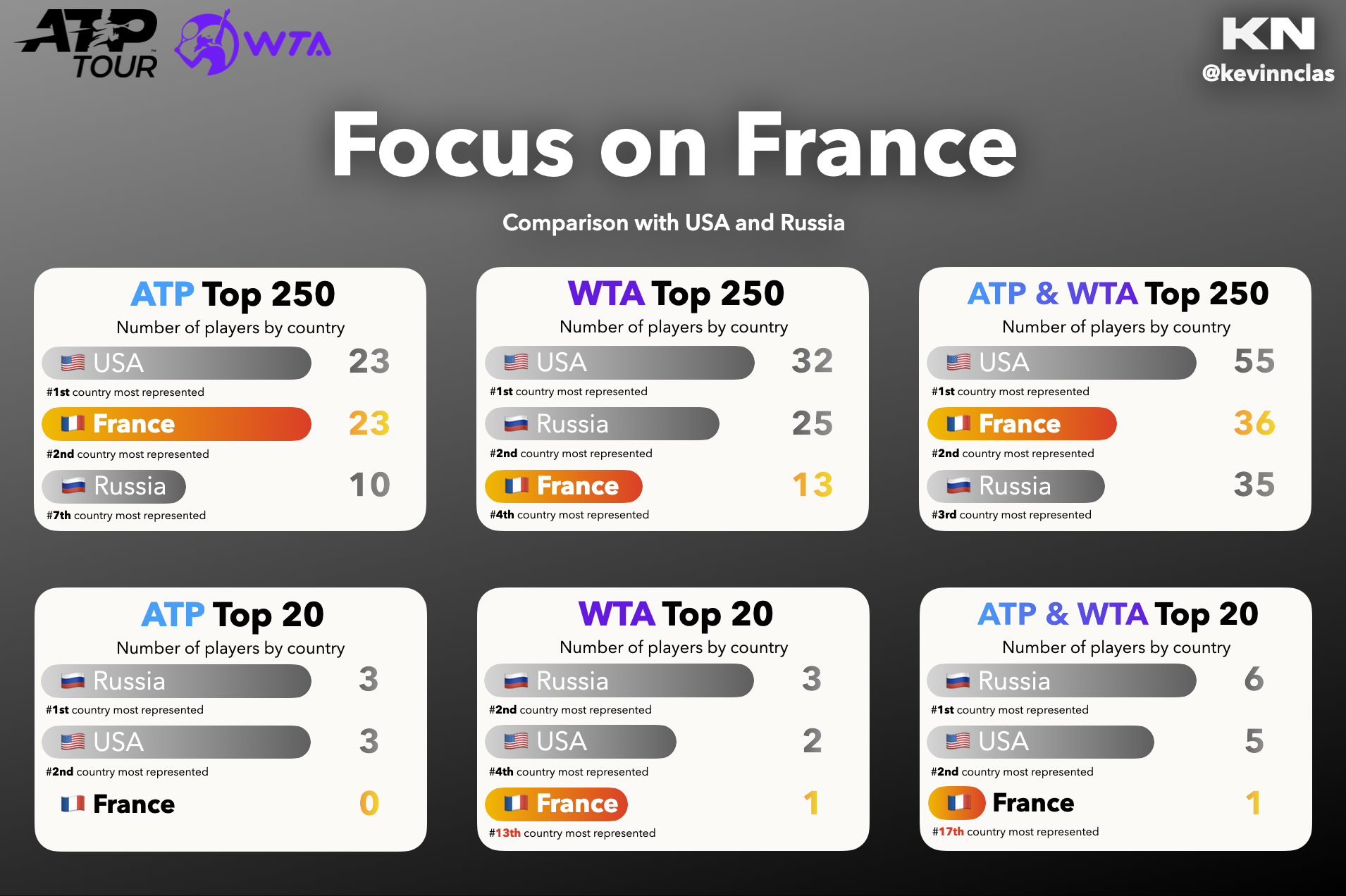
Even if France is one of the most represented country among the top 250 ATP players with 23 players, there is no French player in the top 20 ATP-ranked players.
To compare, the others countries that are the most represented in the top 250, that are USA and Italy, have respectively 3 and 2 players in the top 20.
France is also the 4th most represented country in the top 250 WTA players, with 13 players. Unfortunately, only one player is in the top 20, and that's Caroline Garcia.
Surprisingly, as the second most represented country in the top 250 combined, France as only 1 player in the top 20 combined rankings... In comparison, it's the same amount as Norway, which as only 1 player in the top 250 combined.
Why France underperfoms? 🫤
Compared to USA or Russia, we just saw the difference of performance from France when it comes to have a representative among the best players in the world, i.e. in the top 20 of ATP or WTA.
But why?
I tried to find some possible explanations, that we will discuss now. First, let's look at the popularity of tennis in those 3 countries:
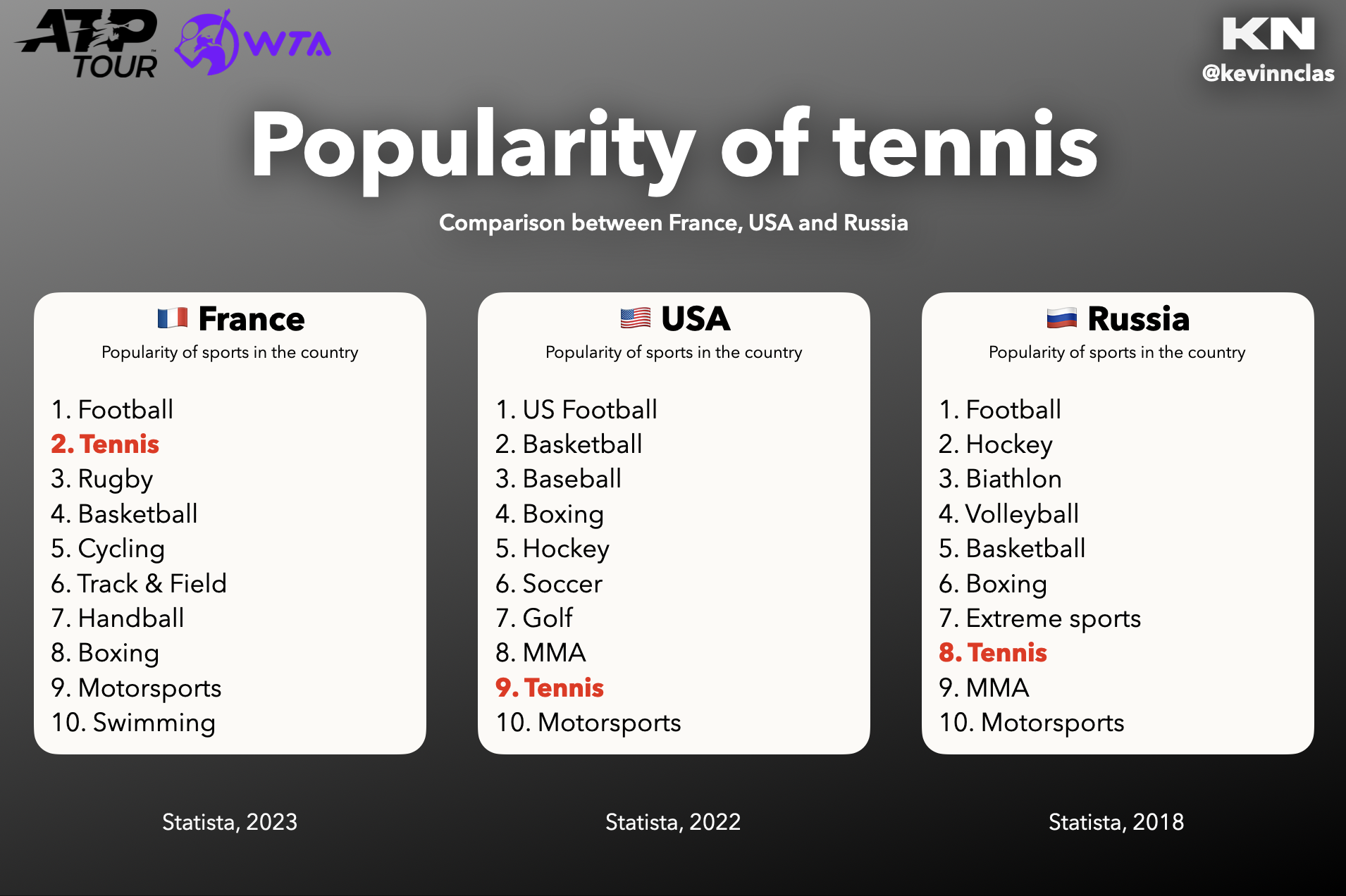
I wanted to compare the popularity of tennis in those 3 countries:
- As we can see, tennis is the 2nd most popular sport in France.
- As for USA, it's only the 9th most popular sport.
- Finally, for Russia, it's also not the most popular sport, because it's only the 8th most popular sport.
The other possible factor I wanted to check is the popluation of the countries. In fact, if a country is more populous, then it's more likely to have more players representing it. Because France is mostly underrepresented in ATP & WTA top 20, let's see the impact of population on the combined top 20:
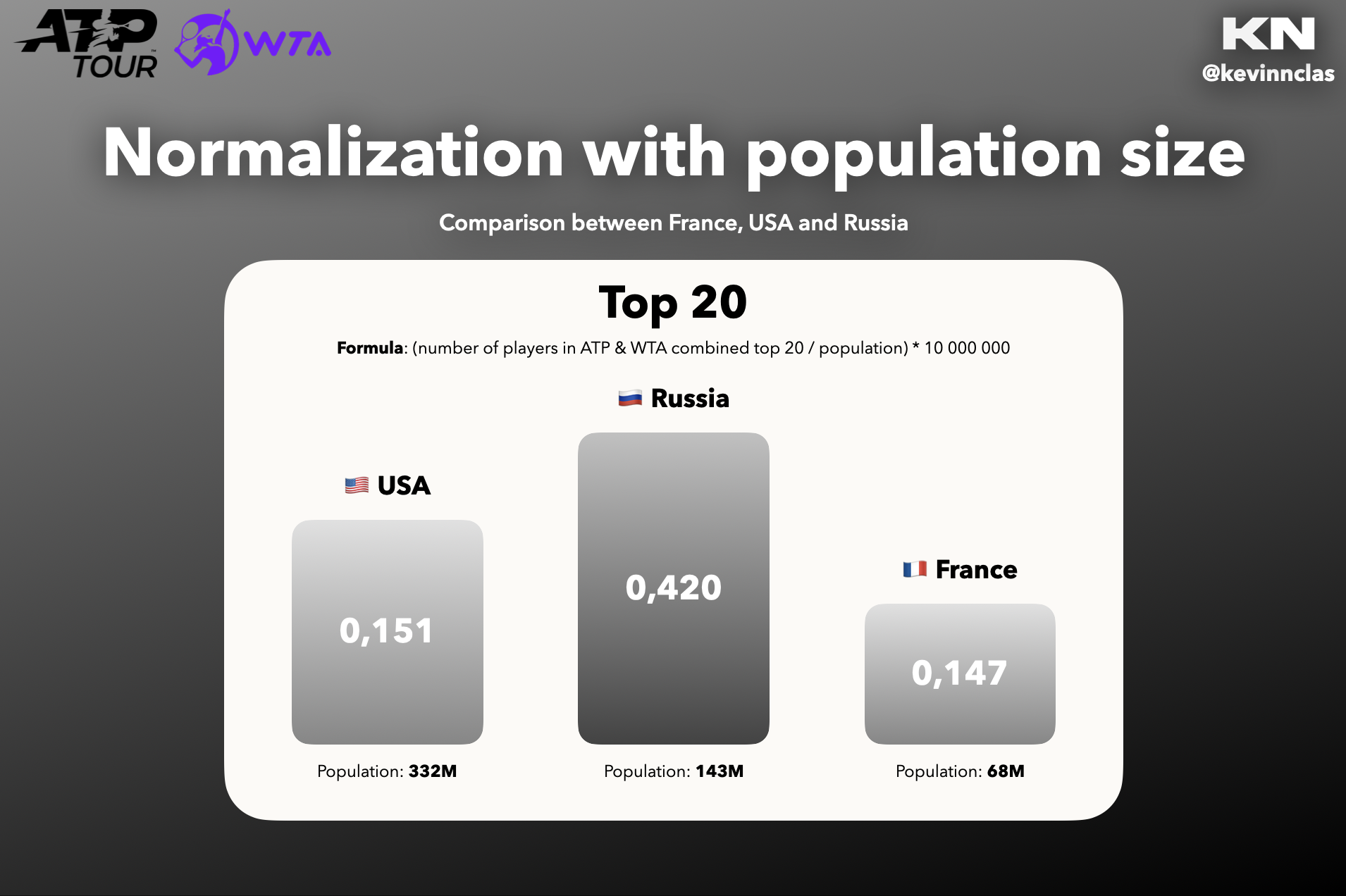
As we can see, Russia becomes now the 1st country in the top 20, if we consider the population size.
However, France stays behind, and doesn't seem disadvantaged by its population size.
To go further 🔍
I didn't really find what can explain the underperformance of France in the ATP & WTA top 20 with the data I had.
To try to explain it, it would be interesting to see, for example: among the 10 first countries in the combined top 20, how much funding has been set aside for tennis development? And how popular is tennis among young people in those countries to develop future talents?
I tried to look those information, but it was very hard to find data about some countries for now. For example, I just found that in 2019, the United States Tennis Association (USTA) announced a five-year, $20 million investment to support the development of young players.
To finish, let's remember that great players can come from everywhere, and it's not where you were born that will make you a great tennis player. Luck is also an important factor that we must think about, and that can't really be measurable.
Thank you for reading !
I did this project because I wanted to discover more about tennis with data analytics. It was an interesting first approach to the subject, and perhaps I'll continue with the data analysis of tennis with the analysis of a player, or a tournament..
If you have any suggestion about the subject or this analysis, feel free to contact me!
Here are my various sources (Jeff Sackmann's data, Statista).
You can check the notebook where I did all the data analysis right here. Thank you very much for reading me and my work, I hope you enjoyed it!
